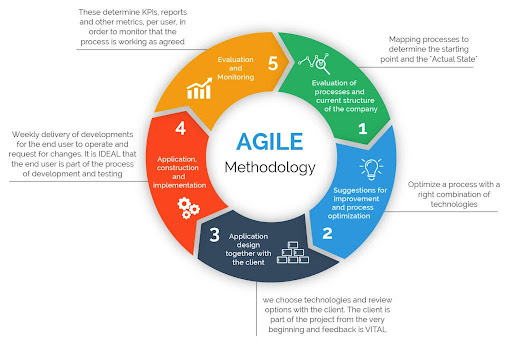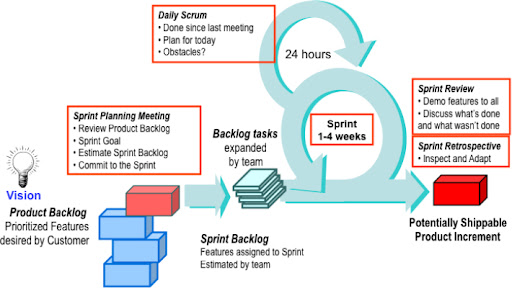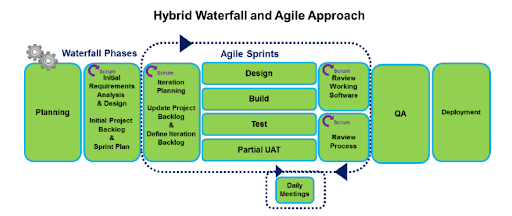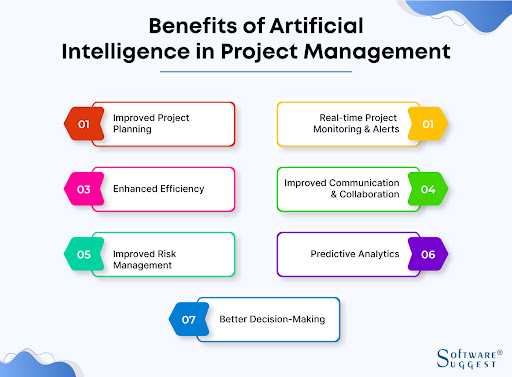Limited Time Offer: Full Feature Access. Plans start @$13 for 11 users Get Started Now
In the fast-paced world of project management, staying up-to-date with the latest trends and innovations is not just a choice; it's a necessity. This chapter serves as your gateway to the exciting landscape of project management trends in 2023 and beyond.

The world of project management is constantly evolving, influenced by changes in technology, the workforce, and global dynamics. As we step into 2023, it's crucial to understand the emerging trends that are shaping the way projects are planned, executed, and delivered. These trends have the potential to revolutionize the field, offering new opportunities for efficiency, collaboration, and success.
This chapter will introduce you to the concept of project management trends and their significance. You'll gain an understanding of how trends emerge, why they matter, and how they can impact your projects, teams, and career. We'll explore how embracing these trends can lead to better project outcomes, enhanced competitiveness, and improved project management practices.
The project management landscape is not immune to change. Technology advances, new methodologies, and shifting business environments continually influence how projects are managed. Those who adapt and embrace change thrive, while those who resist it risk falling behind.
Staying informed about trends empowers project managers to make informed decisions. It provides valuable insights into emerging best practices, tools, and strategies that can lead to more successful project outcomes. It also helps in identifying potential risks and challenges before they become obstacles.
In an increasingly competitive job market, being well-versed in the latest trends and industry knowledge can set you apart. It demonstrates your commitment to professional growth and positions you as a valuable asset to your organization.
The world of project management is a journey of lifelong learning. This chapter emphasizes the importance of continuous education, networking, and professional development as essential components of staying informed.

Agile project management methodologies have transcended their origins in software development to become a driving force across industries. As we venture into 2023, the dominance of Agile remains undiminished, and for good reason.
Agile project management is characterized by its adaptability, collaboration, and customer-centric approach. Teams that embrace Agile principles value customer feedback, iterate quickly, and remain flexible in the face of change. This approach allows organizations to deliver value to their customers faster and more efficiently.
While Agile's roots are firmly planted in software development, its influence now extends far beyond this realm. In 2023, expect to see Agile principles applied in diverse sectors such as marketing, healthcare, manufacturing, and even government.
Marketing teams, for instance, use Agile to respond swiftly to market changes, optimize campaigns, and improve customer engagement. Healthcare organizations adopt Agile to enhance patient care through iterative process improvements. Manufacturers use Agile to streamline production and reduce waste. The public sector employs Agile to deliver citizen-centric services with greater efficiency.
In 2023, project managers are increasingly recognizing the benefits of hybrid methodologies. By blending Agile with traditional project management approaches like Waterfall, organizations can leverage the strengths of each to suit their unique project requirements.
This hybrid approach, often referred to as "Water-Scrum-Fall" or simply "Hybrid Agile," allows teams to maintain a structured project framework while incorporating Agile principles for flexibility and responsiveness. The result is a project management strategy that combines the best of both worlds, ensuring project success even in complex environments.

In the wake of the global pandemic, remote work has transitioned from a temporary necessity to a long-term, sustainable working model. The impact of this shift is profound and will continue to shape project management trends in 2023 and beyond.
Remote work has proven its viability and effectiveness. Businesses have witnessed increased productivity, cost savings, and access to a broader talent pool. As a result, remote work is here to stay, influencing how projects are managed and executed.
Remote work offers team members greater flexibility in managing their work schedules, contributing to improved work-life balance. Project managers must adapt to accommodate these flexible arrangements while maintaining productivity and accountability.
One of the key benefits of remote work is the ability to collaborate with team members and experts from around the world. This global reach can enhance project teams' diversity and expertise, leading to innovative solutions.
Effectively managing remote project teams requires a shift in mindset and the adoption of new strategies. In 2023, project managers will need to adapt and optimize their approaches for remote work environments.
Remote project teams heavily rely on digital tools for communication and collaboration. Project managers should invest in robust tools that enable real-time communication, file sharing, and video conferencing to keep teams connected.
In remote settings, project documentation becomes paramount. Project managers should ensure that project goals, timelines, and tasks are well-documented and easily accessible to team members. This fosters transparency and accountability.
Project management processes and methodologies may need adjustment for remote teams. Agile and Kanban methodologies, for example, offer flexibility and adaptability, making them ideal for remote project management.
As organizations embrace the benefits of both remote and in-office work, hybrid work models are on the rise. This shift presents unique challenges and opportunities for project managers.
Hybrid work models combine remote and in-office work, allowing employees to choose where they work. Project managers must navigate the intricacies of managing teams with varying work locations.
The rise of hybrid work means that project managers should consider workspace flexibility when planning projects. Some team members may require office space for certain tasks, while others prefer remote work.
Maintaining a sense of team cohesion in a hybrid environment is crucial. Project managers will need to devise strategies for effective team synchronization, ensuring that remote and in-office team members collaborate seamlessly.
To successfully manage remote teams in 2023, project managers must leverage a range of tools and implement strategies that foster collaboration, productivity, and team cohesion.
Investing in digital project management platforms is essential. These tools offer centralized project tracking, task management, and collaboration features that are vital for remote team success.
Virtual team-building activities can help strengthen bonds among remote team members. Project managers should schedule regular virtual meetings, team-building exercises, and social events to build rapport.
Monitoring team performance remotely requires clear performance metrics and regular feedback sessions. Project managers should establish key performance indicators (KPIs) and conduct one-on-one performance reviews with team members.

In the rapidly evolving landscape of project management, the incorporation of artificial intelligence (AI) has emerged as a pivotal trend that promises to revolutionize how projects are planned, executed, and managed.
AI, with its remarkable ability to mimic human intelligence, has found its way into the core of project management processes, offering a spectrum of benefits that were once considered futuristic.
One of the most immediate and tangible advantages of AI in project management is its capacity to automate repetitive and time-consuming tasks.
Project managers often find themselves burdened with administrative chores, such as data entry, file organization, and routine communication.
AI-powered tools and software can shoulder these responsibilities, freeing up valuable time for project managers to focus on strategic decision-making and complex problem-solving.
AI-driven automation doesn't merely reduce manual labor; it enhances accuracy and efficiency.
Whether it's auto-generating reports, scheduling meetings, or sending status updates, AI ensures that these tasks are executed flawlessly and promptly, minimizing the risk of human error
Predictive analytics has long been a hallmark of successful project management, enabling teams to anticipate potential roadblocks, allocate resources effectively, and optimize project timelines.
With the integration of AI, predictive analytics reaches unprecedented heights of precision and sophistication.
AI algorithms can analyze vast datasets, historical project performance, and external factors with lightning speed, offering project managers insights that were once unattainable.
By predicting project risks, resource needs, and potential delays, AI empowers project managers to take proactive measures and make data-driven decisions that drive project success.
Chatbots and virtual assistants are becoming integral members of project management teams. These AI-powered entities are available 24/7 to assist project managers, team members, and stakeholders.
They offer real-time responses to inquiries, facilitate communication, and streamline information retrieval.
For instance, a project management chatbot can answer questions about project status, generate progress reports, and even assign tasks based on natural language commands.
Virtual assistants can schedule meetings, set reminders, and provide updates on project milestones. The result is a more responsive and efficient project management environment that keeps everyone on the same page, regardless of time zones or work schedules
As we look to the future of project management in 2023, it is evident that AI is not just a tool but a transformational force. Its ability to automate tasks, provide predictive insights, and enhance communication through chatbots and virtual assistants positions AI at the top.
Every project manager and organization should embrace to remain competitive and efficient in an increasingly dynamic business landscape.
As we step into 2023, one of the most prominent trends in project management is the growing emphasis on sustainability. It's no longer just a buzzword; sustainability has become a central concern for businesses, organizations, and project managers worldwide.
The world is facing environmental challenges like never before – climate change, resource depletion, and environmental degradation are all too real. As a response, organizations are increasingly integrating sustainability principles into their projects. This shift is driven by a sense of responsibility, regulatory pressures, and the realization that sustainable practices often lead to cost savings and competitive advantages.
The integration of sustainability into projects involves aligning project objectives and practices with eco-friendly principles.
Sustainable project management goes beyond simply adopting green technologies or reducing waste. It involves an all-encompassing approach where environmental, social, and economic aspects are considered. Learn how to set sustainability goals and objectives that align with your project's purpose.
Sustainable projects are evaluated using the triple bottom line concept – People, Planet, and Profit. We explore how to balance these elements effectively, ensuring that your project benefits society, minimizes environmental impact, and remains financially viable.
Effective sustainability management requires the ability to measure and quantify your project's environmental impact.
EIA is a crucial step in understanding your project's environmental implications. We discuss how to conduct a comprehensive EIA, identifying potential risks and opportunities for improvement.
Learn about carbon footprinting and life cycle analysis, which help you measure the carbon emissions associated with your project and assess its overall environmental impact. These methods are vital for making informed decisions to reduce your project's footprint.
In the globalized business landscape of 2023, supply chains play a pivotal role in sustainability efforts.
Selecting environmentally responsible suppliers and products is key to sustainable supply chain management. We provide insights into green procurement strategies and criteria for vendor selection.
Efficient resource management and waste reduction are central to sustainability. Discover techniques to minimize resource consumption and waste generation in your projects.
Managing the transportation of materials and products is another critical aspect of sustainability. Learn about eco-friendly transportation and logistics practices to reduce emissions and environmental impact.
In the ever-connected digital landscape of the 21st century, the escalation of cybersecurity threats has become a cause for significant concern across industries.
The year 2023 promises to bring new challenges in the form of sophisticated cyber threats. From ransomware attacks to data breaches, project managers must be vigilant and proactive in safeguarding their project assets, data, and sensitive information. Understanding the nature of these threats is the first step in defending against them.
Cybersecurity incidents come at a steep cost, both financially and in terms of reputation. In 2023, organizations will need to allocate more resources to protect their projects and stakeholders from the potentially devastating consequences of a breach.
Project managers must become adept at integrating cybersecurity best practices into their project management methodologies.
One of the primary cybersecurity best practices involves implementing security measures from the very beginning of a project's life cycle. Project managers should work closely with cybersecurity experts to embed security into project designs, ensuring that potential vulnerabilities are identified and mitigated before they become major issues.
Human error is a significant contributor to cybersecurity incidents. Hence, continuous training and raising awareness among project teams is essential.
Limiting access to sensitive project data is another vital aspect of cybersecurity. Project managers should implement robust access controls to ensure that only authorized personnel have access to critical information.
Data protection and privacy have moved to the forefront of global conversations. As 2023 unfolds, organizations and project managers will be under increasing scrutiny to ensure the privacy and security of their project data.
A myriad of data protection regulations, such as GDPR and CCPA, has emerged globally.
Effective data encryption and secure storage methods are essential components of data protection.
Cybersecurity is no longer an isolated concern but an integral part of risk management in project management.
Assessing cyber risks should be a standard practice during project risk assessments.
No cybersecurity strategy is complete without comprehensive response and recovery plans.
In the digital age, data is not just a buzzword; it's a valuable asset that project managers can leverage to gain deeper insights into their projects. Harnessing data for project insights has become a pivotal trend in the realm of project management.
In recent years, the collection and analysis of project data have become more accessible and sophisticated. Project managers now have the tools and technologies to gather vast amounts of data related to project progress, resource allocation, budgeting, and more.
One of the significant advantages of data-driven project management is real-time visibility into project performance. With the right tools, project managers can monitor key metrics and KPIs as they change, allowing for proactive decision-making and issue resolution.
Predictive analytics has gained prominence in project management. By analyzing historical project data, machine learning algorithms can forecast potential risks, delays, and resource bottlenecks. This enables project managers to take preventative actions and optimize project outcomes.
Data-driven insights also play a crucial role in resource allocation. Project managers can identify underutilized resources, allocate them more efficiently, and ensure that the right resources are assigned to the right tasks at the right time.
Project analytics goes beyond mere data collection; it involves the systematic analysis of project data to extract actionable insights.
Project analytics encompasses a range of activities, including data collection, data cleansing, data analysis, and data visualization. It allows project managers to make data-driven decisions at every stage of a project's lifecycle.
Effective project analytics involves defining and tracking relevant performance metrics and KPIs. These metrics can vary depending on the project's objectives but often include factors like project duration, cost efficiency, and client satisfaction.
The power of project analytics is amplified through data visualization tools. These tools transform complex project data into easily digestible charts, graphs, and dashboards, enabling stakeholders to quickly grasp project status and trends.
Project analytics fosters a culture of continuous improvement. By regularly analyzing project data, teams can identify areas where processes can be optimized, leading to greater efficiency and project success.
Business intelligence (BI) tools have become indispensable for project managers seeking to unlock the full potential of their data.
Business intelligence tools are designed to collect, process, and analyze data to support decision-making. They provide a holistic view of project performance by consolidating data from various sources.
BI tools offer the advantage of customizable dashboards. Project managers can tailor these dashboards to display the specific metrics and insights most relevant to their projects and organizational goals.
Integration capabilities are a hallmark of BI tools. They can seamlessly connect with other software systems, including project management software, CRM tools, and financial systems, creating a unified data environment.
BI tools empower non-technical users to explore data and generate reports without relying on IT teams. This democratization of data access enhances collaboration and decision-making across the organization.
As data takes center stage in project management, ethical considerations and governance become paramount.
Ensuring data privacy and security is a fundamental ethical responsibility. Project managers must implement robust data protection measures to safeguard sensitive information and comply with data privacy regulations.
Ethical data management practices require transparency in data collection, processing, and sharing. Project managers should establish clear accountability for data-related decisions and actions.
Maintaining data quality and integrity is essential. Ethical data practices involve accurate data collection, validation, and maintenance to ensure the reliability of insights generated.
Respecting stakeholder consent and ensuring that individuals provide informed consent for data collection and use are ethical imperatives. Project managers should communicate clearly about data practices and seek consent when necessary.